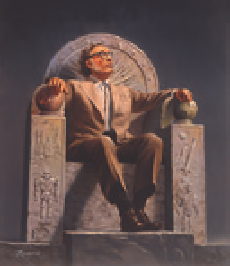Information Technology Reference
In-Depth Information
of electronic tubes, wires, and switches, housed in a bank of steel cabinets
and plugged into a 110-volt A.C. line just like a toaster or a vacuum cleaner.
12
The machine had been designed to do the same sort of tasks for the military as
the ENIAC but in the story, EPICAC is sentient and falls in love with one of the
mathematicians. In the end the machine blows itself up, leaving a suicide note
and some love poems as a wedding gift for his human rival.
Isaac Asimov (
B.17.6
) also assumed that the most powerful computers of
the future would be bigger than the ENIAC.
It wasn't until after computers were invented and the public was made aware
of their existence, that computers began to exist in my stories, and even then
I didn't truly conceive of the possibility of miniaturization.… In “The Last
Question” I began with my usual computer, Multivac, as large as a city, for I
could only conceive a larger computer by imagining more and more vacuum
tubes heaved into it.
13
B.17.6. Isaac Asimov (1920-92) was
one of the most prolific science
fiction authors of the twentieth cen-
tury. His robot stories and his Three
Laws of Robotics have defined the
robot science fiction genre. A little-
known fact about him is that he was
also a professor of biochemistry.
In his 1955 short story “Franchise,” MULTIVAC is a government-run computer
half a mile long and three stories high. The story is a satire on the use of
UNIVAC to predict the result of the recent presidential election from a small
sample of voters. In Asimov's version, the sample size has been reduced to find-
ing the views of the “Voter of the Year” - the single most representative person
in the United States. In another MULTIVAC story, “The Machine That Won the
War,” Asimov reveals some keen insight into the reliability of computers. The
official propaganda is all about how the powerful MULTIVAC computer helped
win the war for the Solar Federation. Yet when the three men whose job it
was to interact with the computer met and discussed their roles, each admit-
ted falsifying part of the computational process. The chief programmer admit-
ted altering the data being fed to MULTIVAC because the people could not be
trusted to supply accurate information in the chaos of war. The engineer then
confessed to changing the data produced by the computer because he knew
that MULTIVAC was not working reliably due to a shortage of manpower and
spare parts. Finally, the Executive Director of the Solar Federation revealed that
he had not trusted the reports produced by the machine and had made critical
strategic war decisions by tossing a coin!
In 1961, the BBC in Britain broadcast a science fiction TV drama about
a computer whose design originated from outer space.
A for Andromeda
was
cowritten by TV producer John Elliot and the famous cosmologist Fred Hoyle
(
B.17.7
). Using their newly commissioned radio telescope, researchers detect a
signal coming from the Andromeda galaxy. The scientist hero, John Fleming,
despite having to contend with constant interference from politicians and the
military, is able to decipher the signal and deduce that it contains the instruc-
tions for building a new type of advanced computer. Fleming fears that the
motivation for those sending the message is ultimately malevolent, but the
military and the politicians insist that the computer be built and, as Fleming
predicted, bad things happen.
One writer who did envision a future with smaller and more pervasive com-
puters was Murray Leinster (
B.17.8
). His short story “A Logic Named Joe” appeared
in the March 1946 issue of
Astounding Science Fiction
. The story is narrated by a
B.17.7. Fred Hoyle (1915-2001) was a
celebrated cosmologist who worked
at Caltech in the United States and
Cambridge in the United Kingdom.
He was one of the originators of
the Steady State theory alternative
to the Big Bang theory to explain
the expansion of the universe -
which has now been ruled out by
experimental measurements. He
also wrote several successful science
fiction novels such as
The Black
Cloud
and co-authored the BBC TV
series
A for Andromeda
. The TV series
featured Julie Christie in her first
starring role.



Search WWH ::

Custom Search